Fiat Funded Bread and Circuses. Bitcoin Tech Talk Issue #221
Happy New Year! 2020 couldn’t be over fast enough and of course, Bitcoin is going parabolic. While the crazy price action is generating plenty of press, the real question on my mind is, how much of this is the depreciation of fiat currency versus the new demand for Bitcoin?
Surely, the two are related, but the expansion of fiat money the past year has been extraordinary. How much of the price increase is due to that versus, say, the halving? If, say, the s2f model is roughly correct, the idea would be that the USD monetary expansion would contribute to the overshoot of the model. The expansion, of course, is a political reality of a economically devastated world.
In other words, we might be underestimating the totality of the macro effects at play here. Stock-to-flow is in a sense, a lower bound for what’s likely to happen. The upper bound is determined by the amount of money printing going on and if that’s the case, Bitcoin could see a higher price than the insanely high prices that are being expected.
Which brings me to my next thought. The current money being printed is to prevent the populace from rioting, which was ostensibly the reason Roman emperors provided bread and circuses. A stimulus check is a crude form of bread and circuses, but it leads me to ask, are we just noticing because it’s so obvious?
Clearly, food stamps and welfare from a certain cynical perspective can be considered bread and circuses, but what about other things? The government, for example, provides rent-seeking jobs and subsidies for all sorts of industries. Many huge companies that provide our food, electricity, cars, gas and so on thrive on government generosity. Could it be that their low prices to us are also a form of bread and circuses?
The current state of affairs from a macro perspective may be closer to Rome during its fall than we think. Thankfully, Bitcoin gives us a way out of the inevitable plundering to come.
Bitcoin
We have a ton of year-end summaries. Jameson Lopp has a great summary of all the stats related to Bitcoin in 2020. These are everything from new user registrations on bitcointalk.com to node counts. His year-end statistics are always interesting and give perspective to how much the Bitcoin network is growing with hard data. Let me just say a hearty thank you for his service to the community in this regard.
Stephan Livera has a summary of how Bitcoin has come along this year from an economic perspective. The savings aspect of Bitcoin has gotten better due to the enhancements in security, which from an economic standpoint makes Bitcoin more useful. Ultimately the argument is that Bitcoin is becoming a better savings technology and that certainly seems to be much better known than, say 3 years ago.
Aaron van Wirdum has a great summary of technical developments in 2020. These include coinjoins, lightning watchtowers, miniscript and DLCs. The summary is a layman’s version of the Op Tech summary from last week. Aaron’s always good at distilling the technical down in easy-to-understand terms and this one is no exception. Send this to anyone who’s not technical enough to read the Op Tech newsletter, but still thinks innovation is happening in some weird altcoin.
BTC Times has an overview of Lightning related developments from 2020. These include elements of all three Bitcoin summaries, like the stats on Lightning, the technical developments and how it’s getting used.
Blockstream has released a new hardware wallet called Jade. It doesn’t have a secure element, but the private key is encrypted on the device and has a different trust model. Essentially, a server is required and the default is Blockstream, though you can run your own. The seed here is secured by both the key material on the device and the pin. Multisig support isn’t there yet, but great to see another hardware device.
Ruben Somsen has a new proposal for sidechains called softchains. This is different than his statechains proposal because there’s a 2-way peg instead of a 1-way peg. It uses something called Proof-of-Work Fraud Proofs to get that 2-way peg work. In addition, there needs to be some way to compress UTXOs (something like UTreeXO would work). The concept is interesting but requires some changes to the Core software to make work. It’s possible this may be a better sidechain concept, than, say elements, though some review hopefully will shed light on the tradeoffs.
Umbrel now has an App Store. Umbrel is a personal node that you can run and the fact that developers can release apps on it is pretty interesting. The interesting aspect of this product is that there will be demand for Bitcoin-adjacent apps, like, say, a Tor gateway. A personal mail server would be another one that I would personally want.
Economics, Engineering, Etc.
Giacomo Zucco has an article on the Hopf cycle. Hopf popularized the idea that hard times create strong men which create easy times which create weak men. His argument is that Bitcoin came out of hard times. He applies the Hopf cycle to what’s coming and the coming need for decentralization. Thinking about the infrastructure that needs to be built from this paradigm would be very useful.
Dan Held argues that Bitcoin is a bold new world. In it, he talks about the precedents of Bitcoin and why the whitepaper drop on October 31st was so significant. Essentially, Bitcoin is much like the Reformation except with the centralized financial system instead of the centralized religious system.
Joe Burnett argues that Bitcoin is the safest asset. The argument is novel in that it discounts volatility and adds more importance to counterparty and dilution risk. Indeed, from those perspectives of not having a trusted third party, Bitcoin is much safer. The article as a bonus shows that from a risk/reward perspective, Bitcoin is much better as well.
Rafael Schultze-Kraft has an article about the supply of Bitcoin. Essentially, Bitcoins are being removed from exchanges and this means that the supply is tightening even more than from the halving. They estimate that 78% of the Bitcoin supply is essentially in cold storage. This may be a major driver of the lack of coins available on exchanges at the moment. People seem to be holding a lot tighter than, say the last bubble.
Russel Okung becomes the first NFL player to be paid in Bitcoin. He’s obviously a huge enthusiast as he’s written the forward for my book (see below). The interesting aspect of this payment is how it’ll look in just a year. If the $6.5M he received ends up being $30M, a lot more athletes will be paying attention. Many athletes tend to be pretty conservative in their investments, but if it’s seen as a safe-haven, this might change things significantly.
Coinbase is being sued by the SEC over XRP. Perhaps it’s payback for their anti-SJW statements, perhaps it’s because they filed to go public, but I suspect there will be some settlement soon. XRP is in a lot of trouble as multiple exchanges have announced its delisting.
Podcasts
I did a Bitcoin anniversary podcast with Tone. This is a very long show, so watch at 3x speed if you can (get a YouTube browser extension if you can’t get past 2x).
My talk from laBitConf is out. It’s animated and short and is essentially the video version of the article at the BTC Times.
My new book making the moral argument for Bitcoin is out! Russell Okung who just got a bunch of his salary in Bitcoin wrote the forward.
Fiat delenda est.












Good Overview of 2020! Ready for the next Bitcoin cycle.